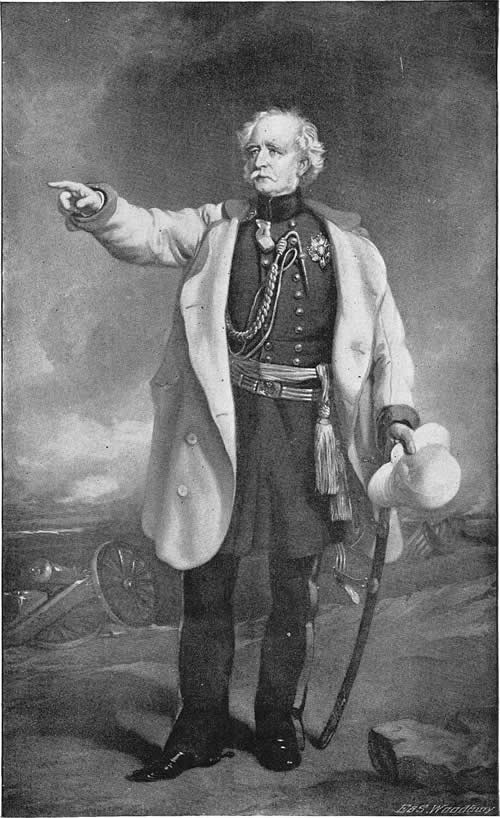|
War broke
out again in the Punjab in 1848. On April 17 Mr Vans
Agnew and Liutenant Anderson, British Agents at
Mooltan, were murdered. On August 18 General Whish
beseiged Mooltan with 28,000 men. Lord Gough arrived
on November 21 and took command of the entire
British force. Next day he advanced to attack the
enemy at Ramnuggur, where both banks of the river
were held by the Sikhs. By a most unfortunate piece
of strategy the cavalry division, consisting of the
3rd Dragoons and the 5th, 8th. and 14th Light Horse,
supported by Horse Artillery, were ordered forward
under General Cureton to dislodge the enemy from the
left bank of the river. This they accomplished with
admirable gallantry, but not without suffering
terrible loss, owing to the difficult nature of the
ground. Colonel Havelock fell at the head of the
14th Light Dragoons ; General Cureton and Captain
Fitzgerald were also killed. On December 2 Lord
Gough crossed the Chenab, and the enemy, after
exchanging a cannonade for several hours, retired
towards the north-west.
 Meantime,
General Whish was carrying on the siege of Mooltan
with an army of 32,000 men and 150 guns. It is
impossible to speak too highly of the splendid
defence made by the Sikhs under Moolraj. By December
29 the British siege guns were bombarding the city
walls at eighty yards range. On the 3oth the
principal magazine in the citadel blew up with a
terrific explosion, and the town was in flames.
Still the brave garrison fought on. The bombardment
continued without intermission for fifty hours. On
January 2, 1849, the town, or the wreck of what had
once been a town, was taken by assault; but the
citadel still held out. Meantime,
General Whish was carrying on the siege of Mooltan
with an army of 32,000 men and 150 guns. It is
impossible to speak too highly of the splendid
defence made by the Sikhs under Moolraj. By December
29 the British siege guns were bombarding the city
walls at eighty yards range. On the 3oth the
principal magazine in the citadel blew up with a
terrific explosion, and the town was in flames.
Still the brave garrison fought on. The bombardment
continued without intermission for fifty hours. On
January 2, 1849, the town, or the wreck of what had
once been a town, was taken by assault; but the
citadel still held out.
From the 4th
to the 18th it was incessantly bombarded, and mines
were exploded at intervals under the walls, till at
last, on the 21st, two wide breaches had been made,
and a general assault was ordered for the following
day. Moolraj anticipated this by unconditional
surrender. His garrison, less than 4,000 men,
marched into the British lines to lay down their
arms ; the last man to leave the fort, in the heroic
defence of which he had won undying glory, was
Moolraj, dressed in gorgeous silks, splendidly
armed, riding a superb Arab with a scarlet
saddle-cloth.
After the
fall of Mooltan General Whish joined forces with
Lord Gough, who, as described above, had driven the
enemy from their encampment at Ramnuggur on November
22. It was believed that the rebellion was broken,
and that the Sikhs would not again meet our army in
the field. But our generals had still to learn the
extraordinary resolution and resources of this fine
race. Chuttur Singh and his son Shere Singh still
commanded nearly 40,000 men with sixty-two guns, and
had captured Attock, a fort defended by Major
Herbert. Gough advanced to attack the chiefs on
January 13, 1849, in their position on the Upper
Jhelum near the village of Chilianwalla, a name of
melancholy associations in British annals. The
Sikhs, indeed, withdrew, but they carried with them
four British guns and five stand of colours. The
British loss was terrible, amounting to twenty-six
officers and 731 men killed, and sixty-six officers
and 1,446 men wounded. Lord Gough was blamed for bad
generalship in this action: he was recalled from his
command, and Sir Charles Napier was appointed in his
place. But fortune was kind to a brave soldier.
Before the orders from home could reach him, Gough,
having followed the enemy, retrieved the disaster of
Chilianwalla by inflicting on Shere Singh a crushing
defeat at Goojerat on February 21, pursuing him into
the Khoree On March 6 Shere Singh surrendered
unconditionally, and on the 29th a proclamation was
by the Governor-General permanently annexing the
Punjab to the British Empire.
Site Copyright Worldwide 2010. Text and
poetry written by
Sir Hubert Maxwell is not to be reproduced without
express Permission.
|